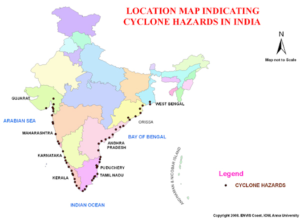About Dynamic Composite Risk Analysis (Web-DCRA) & Decision Support System (DSS)
- National Disaster Management Authority (NDMA) in collaboration with India Meteorological Department (IMD) has developed a web-based Dynamic Composite Risk Analysis (Web-DCRA) & Decision Support System (DSS)
- Tool for forecasting the expected damage associated with the landfalling cyclones over the coastal districts in the country.
- Enable the disaster managers to conduct a better assessment of the vulnerable areas and in mobilizing the mitigation action based on this tool.
- This is under the Government of India’s National Cyclone Risk Mitigation Project (NCRMP) with a view to addressing cyclone risks in the country.
- Objective of the project is to undertake suitable structural and non-structural measures to mitigate the effects of cyclones in the coastal states and UTs of India.
- The National Disaster Management Authority (NDMA) under the aegis of the Ministry of Home Affairs (MHA) will implement this project in coordination with participating State Governments.
- The Project has identified 13 cyclone-prone States and Union Territories (UTs), with varying levels of vulnerability.
- These States/UT have further been classified into two categories,based on the frequency of occurrence of cyclones,size of population and the existing institutional mechanism for disaster management.
- These categories are:
- Category I: Higher vulnerability States i.e. Andhra Pradesh,Gujarat,Odisha,Tamil Nadu and West Bengal.
- Category II:Lower vulnerability States i.e. Maharashtra,Karnataka,Kerala,Goa,Pondicherry,Lakshadweep,Daman and Diu, Andaman and Nicobar Islands.
Project Objectives
- Improved early warning dissemination systems
- Enhanced capacity of local communities to respond to disasters
- Improved access to emergency shelter, evacuation, and protection against wind storms, flooding and storm surge in high areas
- Strengthening DRM capacity at central, state and local levels in order to enable mainstreaming of risk mitigation measures into the overall development agenda.


Source: PIB and ndma.gov.in
















